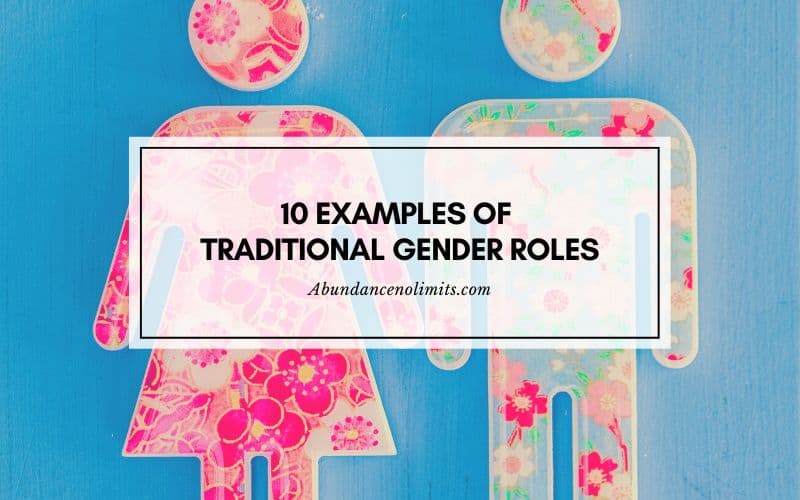How often have others presumed your behavior and actions based solely on your gender identity?
Because you are a woman, you must be a good cook or you are empathetic. A man is expected to make decisions for the entire family or volunteer to carry heavy things.
Often we take these assumptions and expectations in our stride and carry on with our lives without giving this much thought. But these are instances in our lives when this impacts us adversely. That is when we often question the need for male and female gender roles today.
Why do we need gender roles? Isn’t it discriminatory?
Gender roles have existed for as long as mankind. Originally, the need for male and female gender roles was attributed to the biological distinctions between men and women. Men, being physically stronger, were assigned the role of hunter and women became gatherers in the hunter-gatherer societies.
As the human race progressed over centuries and millennia, traditional gender roles changed to suit the current needs, but the basic concept remained the same. Men are still considered the protectors and providers, while women continue to be assigned the role of caregiver.
The core idea behind traditional gender roles is honorable. It’s meant to divide work and responsibilities based on the strength and capabilities of individuals. It’s a way to work together as a unit, supporting each other by fulfilling their own roles.
Unfortunately, fixed gender roles are creating discord in the present society. With the promotion of gender equality and technological advancements, gender differences are blurring fast. One’s physical strengths and capabilities need not define one’s role in society. Despite this, traditional gender roles continue to exist in our societies.
This article takes a look at traditional gender roles existing in our societies today. Here you will find 10 examples of traditional gender roles.
What is meant by traditional gender roles?
Traditional gender roles refer to the societal expectation of how men and women should behave and what they should do. Traditional male gender roles definition considers men as physically strong, brave, and dominating, while women are caring and nurturing.
A family is the smallest unit in society. As such, men and women are assigned work and responsibilities based on the concept of traditional gender roles. This is to help the family function efficiently as a unit, thereby helping society to function well.
10 examples of traditional gender roles
Assigning certain characteristics, behavioral patterns, responsibilities, and work based on one’s gender identity can have disastrous consequences. When you are expected or forced to conform to something based on societal concepts of gender identity can be harmful and troubling.
When you go through these 10 examples of traditional gender roles, it may wake you up to what is happening in the society you live in. This may also prompt you to change your mindset as well as that of the people around you.
1. Women as cooks
In a family, the wife is expected to do the cooking. And also cleaning, grocery shopping, and taking care of the needs of the entire family. Without any basis, women are considered to have an affinity for cooking and other household chores.
Women are assumed to be caring and nurturing and hence considered best suited for running the household. This idea is drilled into the mind of a girl child and a woman who cannot cook is often frowned upon. Media too plays a huge role in promoting these concepts of traditional gender roles.
2. Man works outside; woman stays at home
This is a continuation of the male gender roles examples from hunter-gatherer days. Men are still considered the breadwinner in the family and women as housewives. Earlier these kinds of gender differences made sense as work necessitated physical strength and men are more suitable for it. Women, being good caregivers, are considered ideal for the role of housewife.
However, things have undergone changes in the present society. Even though women are equally qualified and capable of going out and doing skilled jobs, they are still expected to fulfill traditional gender roles which include the responsibility of taking care of their families. This means, working women are forced to take on dual responsibility in today’s world.
3. Women as caregivers
Raising a family and taking care of the needs of others is believed to be a woman’s domain. Besides placing the welfare of the entire family on the shoulders of women, they are also expected to prioritize the desires and needs of others before theirs. Women are also expected to sacrifice their dreams to accommodate the needs of their families.
This is not an easy situation for a woman. Though these concepts of traditional gender roles are changing gradually, the pace of change is not fast enough in some parts of the world. Even in modern societies, these traditional gender stereotypes exist in some form or the other.
4. Men need to be chivalrous
A chivalrous man is kind, honest, fair, and polite with women. He has to be on his best behavior in the presence of a woman. He needs to be protective of the woman in his life. This may include performing hard tasks and carrying heavy things.
A chivalrous man always opens the doors for a woman and draws a chair for her, offers his coat to keep her warm, gives up his seat for her, and walks on the roadside to shield her from oncoming traffic. Though all these actions are desirable in a human being, expecting this only from men is what makes it look bad. Traditional gender roles tend to breed inequality in today’s world.
Moreover, chivalrous men aren’t expected to cry. They should manage their emotions by bottling them up as they are physically and emotionally stronger than women. Gender differences are sometimes skewed against men as well.
5. Men as engineers, women as teachers
Men are ideal as doctors, while women make good nurses. Career choice is one place where gender differences still exist in most societies. As an extension of their nurturing role at home, women are considered to be better suited for teaching children or tending to sick patients. Traditional gender roles tend to prevent women from realizing their dreams.
Though women are becoming engineers, doctors, and even astronauts, even today, teaching is considered an ideal profession for women. Some women have managed to break the glass ceiling and enter the traditional professions of men. But pay disparity is a stark reality even today across the world.
6. Sons as achievers, daughters as homemakers
From an early age, sons are given extra attention and care in the family, while daughters are often neglected. While sons go for higher education, daughters have to make do with limited chances. Girls are taught to pick good partners, have kids, and raise a family, either consciously or otherwise.
This is based on the notion that men are more intelligent than women. Science has proved time and again that there is no distinction between the brains of men and women. Women are equally capable of learning and working the same as men. Gender differences regarding intelligence are just myths. Traditional gender roles end up supporting and strengthening such gender inequalities.
7. Men as disciplinarians, women as nurturers
The gender stereotypes of men and women are still prevalent in all parts of the world in some way or the other. Women, being kind and compassionate, are considered incapable of ensuring discipline, be it at home or in any other setting. On the other hand, men are considered emotionally strong and tough. They are less swayed by bonds and emotions, thereby better at enforcing discipline.
Women are more concerned about bonding with others and maintaining harmony in any relationship. This makes them agree with others and conform to their opinions to prevent discord. However, men are more likely to hold on to their opinions, refuse to conform, and act independently. This makes men better disciplinarians than women. Traditional gender roles do not serve the interests of either gender.
8. Men wear pants; women wear skirts
And boys are associated with blue color and girls with pink. In fact, a century back, it was the other way around. It was all media hype and started with Time magazine publishing sex-appropriate colors for boys and girls in the 1920s. Though this may seem like one of the innocent and inconsequential traditional gender roles examples, it plants deep-rooted gender bias in our minds as early as birth.
The same applies to pants and skirts. At some point in history, these were considered appropriate dress choices for men and women and it has stuck with us through centuries. Now, women wear pants, but society still looks down upon a man who wears skirts. Gender differences in clothing are a stark reality.
9. Building blocks for boys and dolls for girls
Or boys go out and play in the open, while girls play inside. It’s considered normal for girls to cry, while boys are supposed to be tough and shouldn’t cry. Imposing such restrictions based on gender stereotypes on young minds will have long-lasting consequences.
Boys are expected to be more physically active and show an inclination to sports. They are also expected to excel in their studies and end up with a good career. However, there are no expectations from girls in most societies even today other than learning how to do household chores and manage a household.
Though some girls have managed to break out of these entrenched traditional gender roles and defy gender stereotypes, boys rarely show interest in “girly” activities.
10. Men are persuasive; women are bossy
The same behavior from men and women is interpreted differently because of the bias in societal expectations and their assigned traditional gender roles. Gender differences are as clear as daylight in today’s world.
As women are expected to be docile, when they are strong, decisive, and assertive, they are branded as pushy and bossy. On the other hand, when men behave the same way, they are appreciated as confident, independent-thinking, and influential.
Men are allowed to show their dissent and anger and act aggressively, while women are expected to be gentle, reserved, respectful, compliant, and dutiful. Devotion and loyalty are highly appreciated in women, while a man is appreciated for holding his ground and acting independently.
Bottom line
Traditional gender roles definition in the context of a family dictates that women stay at home and take care of the home while men go out to work and earn. The word “housewife” says it all. Men are more interested in playing outdoor sports whereas typical hobbies for women are knitting, embroidery, and gardening.
In the world of relationships, gender differences are so visible even today. Men are expected to ask women out and pay on a date. Men are also expected to propose and take the lead in every aspect of the relationship. Women are desirable when they are pretty and petite. On the other hand, a man’s appeal is decided by his toned body, broad shoulders, narrow waist, sharp jawlines, and high cheekbones.
Our original reason for assigning traditional gender roles is long lost in the annals of history. Despite the big strides we have achieved in gender equality and parity, traditional gender stereotypes exist in our midst in various forms under some guise or the other.
Mind conditioning can have a huge impact on our behavior, choices, and how we relate to others and live our lives. This is all the more reason why we should focus more on what our strengths are and what we want to do. And, not on what is expected of us.


